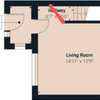Celotex or Actis Triso Sol for underfloor heating
Ben Siegmund
7 years ago
We are in the process of refurbishing our house and want to install a wet underfloor heating under a screed and porcelain tile floor.
Having taken up the existing floor we were surprised to find a solid concrete base (we were expecting suspended timber). The original idea was to take up the suspended timber and replace with block and beam, however having a solid concrete base has worked in our favour from a cost perspective.
The downside is that we now have a floor level we are more or less stuck with (to remove the existing concrete base will be expensive and possibly uncover any number of sins). The question is:
Do we put down Celotex or Triso Sol under the underfloor heating? Celotex is much more transparent in their detail (performance figures and data) and has a much lower cost; Triso Sol is a little more of an unknown with quantifiable information about its efficiency very hard to come by and it is also a fairly hefty price tag by comparison.
The dilemma comes from not wanting to lose ceiling height. In using Celotex, we will lose around 150 - 170mm, but with the Triso Sol this is halved.
If Triso Sol can come close to the performance of Celotex, I am happy as I would forgo some efficiency to maintain the ceiling height, but in the absence of any meaningful data on Triso Sol, I am sceptical about how good it really is.
Houzz uses cookies and similar technologies to personalise my experience, serve me relevant content, and improve Houzz products and services. By clicking ‘Accept’ I agree to this, as further described in the Houzz Cookie Policy. I can reject non-essential cookies by clicking ‘Manage Preferences’.






Jo Chrobak Invent Design Create Ltd